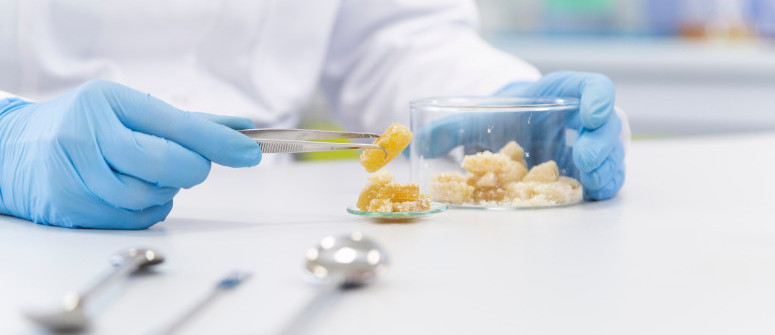What is cbda: everything you need to know

If you've been to any sort of health store over the past few years, you likely know about CBD. What you may not know is that CBD doesn't really exist in live cannabis. Rather, you'll find an abundance of CBDA, the chemical precursor to CBD. Like CBD, CBDA has been observed to have a wide range of potential benefits. Let's dig in!
Cannabis and hemp research has dominated public health discussions for the past few decades. Reading article after article, each filled to the brim with acronyms, it must feel like you know every cannabinoid out there. There's one that's seldom discussed, though, and it's closely related to one we enjoy the most. Without further ado, allow us to introduce CBDA: the chemical precursor to CBD—and a potentially beneficial compound in and of itself.
WHAT IS CBDA? WHAT DOES CBDA STAND FOR?
CBDA, which stands for cannabidiolic acid, is one of 100+ cannabinoids that can be sourced from cannabis and hemp plants.
In case you aren't familiar, cannabinoids are compounds capable of interacting with the endocannabinoid system in our bodies, among other molecular targets. These interactions are vital, as said system is linked to many important physiological functions. That fact, in turn, has catalysed virtually all of the cannabinoid research we've seen over the years.
Fortunately, some of that research has showcased CBDA as a potential therapeutic for several different health issues. Research is still in the early stages, but the unique mechanism of this cannabinoid is certainly worth exploring.
HOW IS CBDA MADE?
Before we can discuss the benefits of CBDA, we should consider how it comes about. It, like THC and CBC, stems from CBGA (cannabigerolic acid). Then, synthase enzymes interact with CBGA to produce varying ratios of THCA, CBCA, and CBDA. More specifically, CBDA synthase interacts with CBGA to convert the compound into CBDA.
While CBDA can continue to exist as is, it’s likely for the cannabinoid to eventually undergo decarboxylation. The term refers to the process by which a "carboxyl group" is removed from a compound and CO₂ is released. This happens, simply enough, when CBDA is heated to a certain temperature or exposed to sunlight for long enough. As this heat and/or sunlight exposure occurs, CBDA is converted into its popular descendant, CBD.
ARE CBD AND CBDA THE SAME?
They have similarities, yes, but their differences are key to understanding their effects.
Chemically, as we just discussed, CBDA has a whole carboxyl group that CBD does not. In other words, CBDA could be considered “raw”, while CBD is “activated”. In turn, while they're both cannabinoids, they interact with the endocannabinoid system and other molecular targets in somewhat different ways.
CBD doesn't bind directly with cannabinoid receptors, instead working indirectly to boost endocannabinoid production, among other functions. The cannabinoid has also been shown to produce effects via other receptors, including serotonin receptors, PPARs, and numerous others.
CBDA works through similar and different pathways, but is intriguing in its own right. Like CBD, it doesn’t show a major binding affinity for CB1 or CB2. However, an indirect relationship with the ECS allows CBDA to inhibit the enzyme COX-2 (cyclooxygenase-2).
WHAT DOES CBDA DO?
• Inflammation
This very function is what's led researchers to believe CBDA has potential as an anti-inflammatory. In a 2008 study, researchers noted that CBDA had a striking structural similarity to many nonsteroidal anti-inflammatory drugs (NSAIDs).
Their common factor, as it turns out, is their ability to block the COX-2 enzyme. When compared to THCA in the same study, they found THCA to be comparatively weaker since it lacked moiety, the specific carboxylic acid in CBDA. Yes, further clinical trials need to be conducted, as molecular similarity isn't outright proof, but results are promising nonetheless.
• Chemotherapy-induced nausea
Even then, the usefulness of CBDA in clinical contexts may extend even further. In particular, those with chemotherapy-related nausea may have a more effective alternative to CBD on their hands, according to a 2013 study.
In the study, researchers tested the relationship between CBDA and ondansetron (OND), an anti-nausea medication for chemo patients. Through the study, they found CBDA and OND to be far more effective than CBD and OND at reducing nausea via indirect agonism of the 5-HT1A receptor.
Let's be clear, though; this study was conducted on rats, not humans. But, if you keep yourself updated on future studies, you may be pleasantly surprised.
• Anxiety
CBDA’s potential appears to extend to the psychological realm as well as the physical. In a 2018 study on depression-like behaviours, researchers stabilised CBDA by converting it into cannabidiolic acid methyl ester, referred to as HU-580. This CBDA derivative, thankfully, retained its root compound's anti-anxiety properties, while still being stable enough to work as a clinical-grade drug.
WHERE CAN YOU FIND CBDA?
You shouldn't have any particular expectations for CBDA at this point, but it's still safe to try, and we recommend doing some experimentation. If you have access to live cannabis or hemp, you could take some uncured buds and add them to a smoothie or juice to harness the “raw” cannabinoid.
Your best option is to find a high-quality full-spectrum CBD oil and make sure it contains CBDA. Since these oils feature bits of every crucial plant compound, they'll likely be the most abundant source of CBDA. The label won't normally mention it, but it'll show up on lab screenings, which reputable brands normally provide.
If you don't know where to start, we're happy to offer a quality selection of full-spectrum CBD oils. If you want verification, you can check out our lab results and see the CBDA levels for yourself.
No matter what you select, be sure you're doing it safely.




